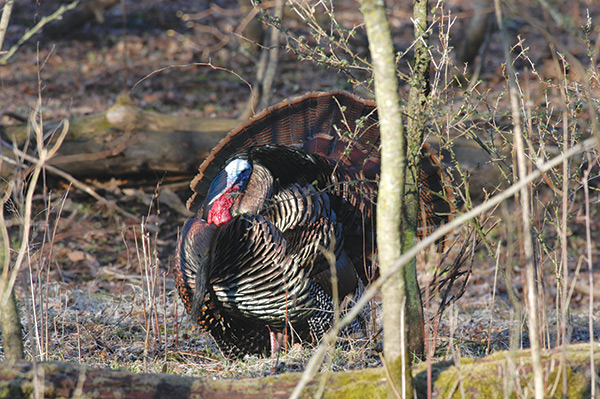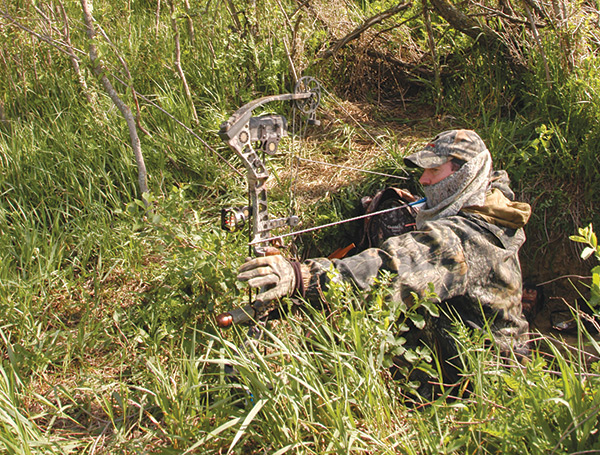 Hunting Turkey: Bag the Boss with a Bow
Hunting Turkey: Bag the Boss with a Bow

The setup looked perfect as I quietly placed clipped spruce branches around a small triangle of oaks to create a dense visual background. The makeshift blind sat atop a bare dirt irrigation ditch overlooking a pasture dotted with mature ponderosa pines, below a slope covered with thickets of oakbrush and larger pines.
As I carefully finished the blind, a longbeard roosted several hundred yards up the hill let loose with a mighty gobble, announcing his intentions and location to every hen in the valley.
The dirt directly in front of the blind along the top of the ditch was already beat down with turkey tracks and wingtip drag marks.
Like I said—a perfect setup.
Well before daylight the following morning, I was snuggled back in the tight confines of that blind with an arrow nocked, listening to the gobbler sound off, waiting for him to fly down. I’d set a hen and jake decoy 15 yards in front of the blind, with the jake facing the blind. I figured the gobbler would challenge that decoy either face-on or broadside, giving me a good target.
Half an hour before fly-down time, I tree-called softly and got an immediate response. An hour later, the gobbler flew down and I coaxed him close with a few soft clucks.
He ended up strutting at point-blank range—but 5 yards directly behind my blind. No way could I turn for a shot; my only recourse was to sit and hope he would come around to the front. I knew I’d lost him the moment hens started yelping on the hillside behind me. The spittin’ and drummin’ that had been going on for more than an hour lapsed into dead silence. I called for another hour and got an occasional response from the gobbler, but he followed those hens up and over the ridge.
So much for the perfect setup.
But failure can be a great teacher, and when I climbed out of that blind I’d already figured what had gone wrong and how to fix it. When I’d set up the blind, I had literally been “blinded” by all of the sign on the ditch bank. Location is the key to every good turkey setup, especially if you hope to bag the boss with a close-range arrow. And I was certainly on location. But I had unnecessarily limited my shooting angles by trying to get too close to that one perfect spot.
I built another brush blind 20 yards farther up on the hillside, a vantage that covered the whole ditch top, including my previous blind and the small strutting area immediately behind where the gobbler had snergled me. I removed all sign of the original blind.
A week later, I positioned a companion in this new brush blind and then sat myself at the base of a huge ponderosa a few yards above and commenced calling. The gobbler again strutted on the ditch top behind the original blind location, and my companion made the easy shot.
Bowhunting solo can be the epitome of challenge, because the calling centers the gobbler’s attention on the hunter’s exact location. A gun hunter may lock into shooting position at the earliest opportunity and then only swing the gun barrel a couple of inches, click off the safety and squeeze the trigger. But a bowhunter has to rise up and draw the bow, and doing that without being detected is never easy.
I’ve observed neophyte hunters try to hide behind cover rather than use cover as a background, but that only cuts down on possible shooting angles. Better is to set up in front of a background that matches the camo. A light pattern against a dark background is a dead giveaway to a sharp-eyed tom, and the human head and shoulders outline is a huge alert flag. This is why a ghillie suit can be so helpful. It lets the hunter blend into the background without the distinct head-and-shoulders outline.

If you plan on hunting in a ghillie suit, be sure to practice with your bow and arrow in the same suit, under simulated hunting conditions, taking shots from a number of realistic angles and positions. I lost a longbeard one spring morning while wearing a new ghillie suit because I hadn’t bothered to do this. The big gobbler came within 15 yards without a clue that I was kneeling in plain sight, and I came to full draw when he went behind a tree. As he stepped into the open, I released.
But the bowstring caught in the burlap of the ghillie suit sleeve, throwing the arrow off target. Needless to say, I didn’t get a second shot.
Double teaming is a good tactic for bowhunters, far less stressful than hunting solo. One hunter gets set up for the shot while the other does the calling, keeping an incoming bird diverted away from the shooter. Since we started booking archery hunts in the spring, our clients have taken more birds with this tactic than any other.
Patience is the other key. Used to be when I located a gobbler, I hurried to get set up and start calling. Age and experience have slowed this considerably. I now take my sweet time getting comfortably settled in the very best location, with every aspect considered before I make the first call.
I’ve often stated, and proven on occasion, that I could bag a gobbler wearing Levis and a red shirt, as long as I could set up somewhere back in the shadows. Even took a gobbler with bow and arrow while wearing a blaze orange shirt, just to see if it could be done. Always take into consideration where the sun and shadows are going to be while you are hunting; choose ambushes that take full advantage of any shade, preferably with the sun at your back.
The proliferation of portable pop-up blinds with pass-through arrow windows has dramatically increased the percentage of turkeys taken each spring by bow. Turkeys pay little attention to the shape of a blind, and since they don’t have a keen sense of smell (thank goodness), such blinds can nearly always be positioned in advantageous locations.
Several years ago, a rather hyper bowhunting client just couldn’t sit still. After several futile attempts, I finally went for a pop-up blind.
At 3:30 p.m., I quickly and quietly set the blind at a wooded edge overlooking a CRP field where the decoys would have maximum visibility. Since the shooter was right-handed, I set the hen and jake off to the left a bit, with the jake facing the blind at 20 yards.
When using decoys, always remember to set them in proper position to give the shooter the widest angle of coverage. On several occasions early in my guiding career, I set decoys for a right-handed shooter only to discover he was left-handed. Nowadays, I ask. I also ask gun hunters to take a few practice shots with their off-hand, because you never know with turkeys.
Switch-hitting isn’t an option for bowhunters, so setup has to be right.
I use different setups depending on the situation but generally prefer a jake with breeding colors and a hen or two to pique the gobbler’s dominance urge. I set the jake facing directly at the hunter, 10-20 yards out depending on the hunter’s comfortable shooting distance.
Normally, a tom will either present a broadside shot while circling or directly face the jake decoy, presenting a back shot. If the turkey fans out, so much the better. There’s a perfect bull’s-eye at the center of the fan.
I prefer stout 3- or 4-blade broadheads for turkeys, and while I am not a fan of expandable-blade broadheads for deer and other big game, they work well on lighter-boned turkeys. I know some advocate head shots, but I’ll stick with aiming at the wing butt on broadside shots and the center of the back or bung hole when the bird is facing away.
If the bird is facing me, I wait, figuring I am not going to be able to draw without being seen, anyway.
But back to my story: A gobbler came out of the woods and faced off with the jake decoy, giving my fidgety friend a perfect shot.
I also put hunters in pit blinds that were originally dug for whitetails; they work superbly for turkey bowhunting.
Turkeys don’t have much sense of danger from below ground level. The pit blinds are placed with maximum visibility for decoys, and the openness of the area brings gobblers in totally unsuspecting. A brushy backdrop and camo do the rest. I dig the pits 6 feet long, 6 feet wide, and 3 feet deep with a dirt bench seat left along the back where a shooter can draw and release from a sitting position without rising up. I plant brush and grasses around the blinds for natural cover. Once in place, they are almost maintenance free—and nobody is ever going to steal one.
I’ve tried on several occasions to bowhunt turkeys out of tree stands without much success; the turkey’s fear of danger from above, and the openness of the stand, make it all but impossible to draw a bow without being detected.
Taking a gobbler with bow and arrow is the epitome of the hunting challenge, and everyone who does it truly earns their spurs.